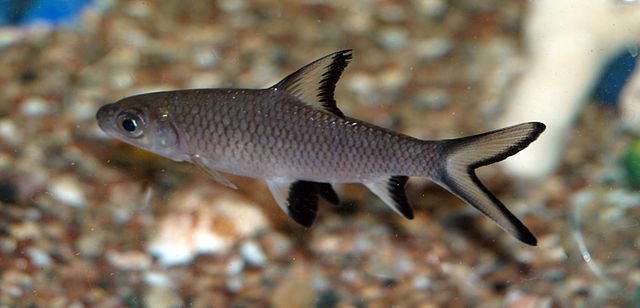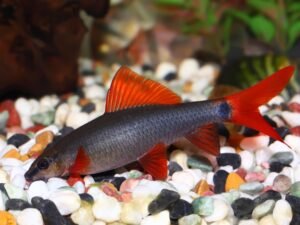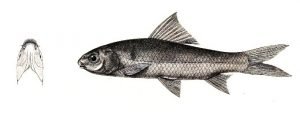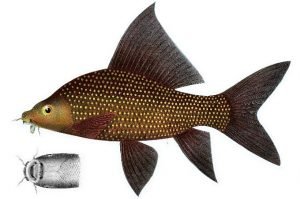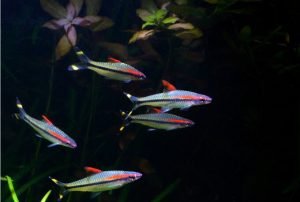This comprehensive Bala Shark Care Guide is designed to provide detailed insights into the proper care and maintenance of these remarkable aquatic species.
Bala sharks (Balantiocheilos melanopterus), are a stunning freshwater fish that has caught the attention of many aquarium enthusiasts. They are native to the streams and rivers of South East Asia and can be found in a range of habitas from swift-flowing waters to large rivers and natural lakes.
Whether you are experienced with keeping aquarium fish or a newbie considering adding your first Bala shark to your collection, tis comprehensive Bala shark care guide will equip you with what you need to know to ensure the well-being and success with keeping this awesome fish.
Bala Shark Care Guide
Bala sharks, also known as Silver Bala, Silver Shark and Tricolored Minnows; are not actual sharks but were named because of their torpedo-shaped bodies, triangle dorsal fin, and rigid fins, resembling a shark. Bala sharks inhabit freshwater environments.
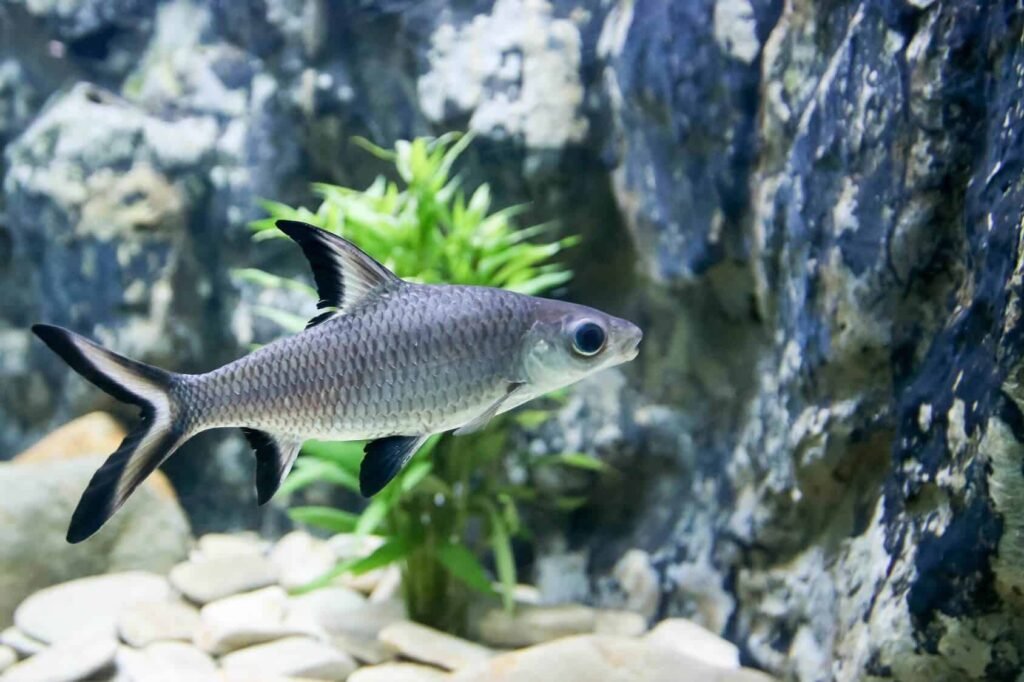
Description
A popular fish among hobbyists, it has a silver body with black margins on its dorsal, caudal, anal, and pelvic fins.
Prices pulled from the Amazon Product Advertising API on:
Product prices and availability are accurate as of the date/time indicated and are subject to change. Any price and availability information displayed on [relevant Amazon Site(s), as applicable] at the time of purchase will apply to the purchase of this product.
It has a grey body with slightly uneven gradients, with closely spaced scales that allow for effortless movement through the water. Bala sharks have large eyes allowing it to cruise around the tank and survey all the goings on.
How Large Can the Bala Shark Grow?
In the wild, Bala sharks are considered to be rare. The fish available in aquarium shops are typically bred in fish farms.
They can reach lengths of up to 1 foot or 13 inches, making this species very large for the average home aquarium. These “sharks” require spacious tanks to accommodate their size.
Fish shops sell juvenile Bala sharks that are usually around 3 – 4 inches long. These fish, if fed right in a good sized tank, can grow up to six inches in one season.
The Bala shark is a schooling fish and are much happier when kept in a group. For that reason, people keeping this species will need a tank to accommodate many individuals.
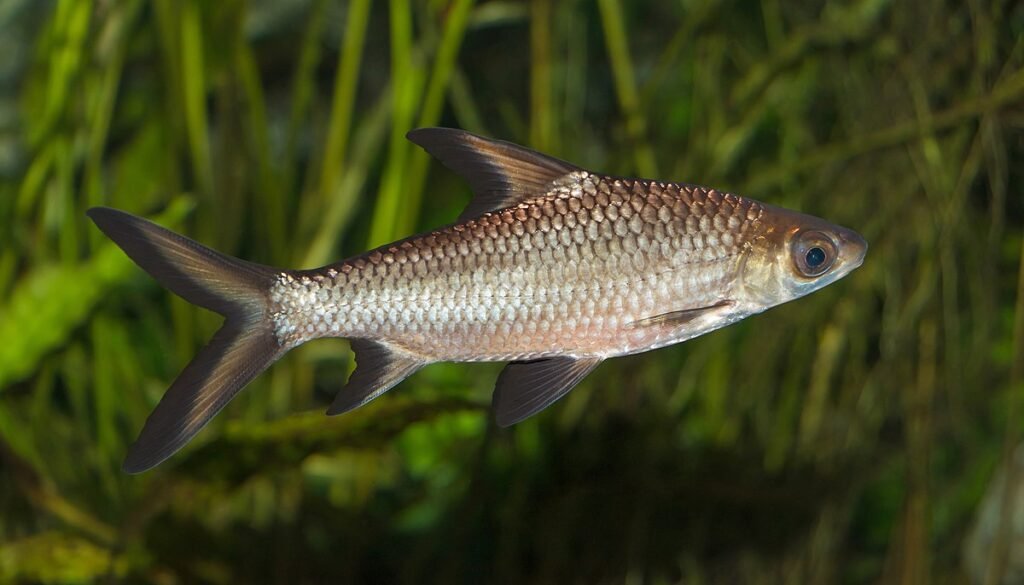
Origin and Distribution of the Bala Shark
Once prolific in Southeast Asia, the Bala shark has experienced a great decline in its numbers in the wild. There are concerns that it has become extinct in many areas where it used to be common.
Today it is a threatened species. It has been on the IUCN Red List since 1996.
Habitat degradation, environmental changes like river damming, over-fishing by the aquaculture industry, and increasing water pollution are all factors that have contributed to this species decline in population.
Bala Shark Care Guide: Ideal Habitat and Aquarium Tank Size
Ideal Habitat:
Prices pulled from the Amazon Product Advertising API on:
Product prices and availability are accurate as of the date/time indicated and are subject to change. Any price and availability information displayed on [relevant Amazon Site(s), as applicable] at the time of purchase will apply to the purchase of this product.
- Water sensitivity: Sensitive to water conditions and temperature, prone to Itch (white spot disease) and bacterial infections in high temperatures.
- They will jump: Tightly covering the fish tank is important as Bala Sharks have a inclination to jump when disturbed.
- Swimming space: Decorate the tank with large, secure plants around the edges, leaving plenty of space in the center for swimming.
- Outdoors: Ensure warm temperatures throughout the winter and provide a sheltered area from the elements. Alternately, keep them in ponds during the summer and in a heated aquarium during winter.
- Well-oxygenated water: This is essential, and a circulation pump can be used in moderation to simulate a flowing environment like what they would have in their natural habitat.
Aquarium Tank Size
When keeping a number of individuals in the tank it is crucial that you provide a spacious area for them to swim and interact. Bala sharks are very active fish who will swim about the tank quickly. Here are some points to note:
- Require a tank size of at least 100 gallons.
- Include aquarium décor for sharks to hide in amongst.
- Being excellent swimmers accustomed to fast-flowing water, they should be housed in a longer tank, rather than a deeper tank.
- Maintain regular water flow by using flow pumps to create currents and increase oxygen levels.
- Ensure the tank has a top glass cover to prevent fish jumping out.
- As they grow larger, they will need to be moved to larger aquariums.

Bala Shark Care Guide: Maintaining a Healthy Aquarium Environment
Bala shark are a hardy freshwater fish species and their care is relatively simple. Here are some suggestions to keeping them healthy:
- Clean Aquarium: Regularly clean the aquarium and ensure water chemical levels and temperatures remain stable for optimal conditions. Bala sharks are vulnerable to diseases if the water becomes polluted. Maintain clean water with a suitable biological filter to mimic their natural habitat.
- Fresh and Nutritious Food: Provide them with a quality balanced commercial food. Add variety with the addition of live foods.
- Monitor Behavior: Erratic behavior like swimming between themselves, playing dead, or crashing into glass walls may indicate that aquarium parameters are off or they lack sufficient swimming space.
Prices pulled from the Amazon Product Advertising API on:
Product prices and availability are accurate as of the date/time indicated and are subject to change. Any price and availability information displayed on [relevant Amazon Site(s), as applicable] at the time of purchase will apply to the purchase of this product.
Unless your setup has a large sump tank and efficient biological filter, regular cleaning and water changes are necessary to maintain good water quality. Performing partial water changes every week or two helps remove accumulated waste and maintain optimal water conditions for the fish.
Bala Shark Water Parameters
Maintain appropriate water conditions for your Bala Shark. The recommended pH range is between 6.5 and 8.
Aim for a water hardness of 12 dGH. Set the temperature to between 76°F and 80°F.
Regular water testing will ensure that the environment is right for these fish, avoiding health issues.
Temperament of the Bala Shark
Although Bala sharks get big, they are mostly peaceful with other fish in the tank and rarely eat smaller fish, unless tiny the fish are tiny fry.
Balas are very outgoing, and will spend much of their time interacting with one another and exploring the aquarium. They will establish a hierarchy with the other Bala sharks in the group. It is recommended to keep a group of five or more specimens to prevent harassment of subdominant members. As the fish reaches sexual maturity this behavior become more apparent.
When fish are first introduced to an aquarium, they may initially be timid and easily startled. They may seek to hide in amongst plants and decor. Once they have settled in, the Bala sharks will actively swim about the tank, liking the open spaces.
This species of fish will jump, and accidents may happen if the aquarium doesn’t have a secure cover.
A common injury to fish that have been recovered after jumping out of the tank is the loss of the slime coat over the eye. Treatment should be provided to restore the slime coat eyes.
Balas can be quite greedy eaters and can scoff food presented before slower fish get a chance to eat their share. Other than that, they are generally peaceful and do not pose significant challenges.
Suitable Silver Shark Tankmates
Bala sharks have a peaceful nature. They usually get along well with other calm natured and similarly-sized fish species that can endure their active swimming behavior. To prevent conflicts and undue stress, aggressive or territorial fish, like aggressive African Cichlids, should be avoided as tankmates.
Juvenile Bala sharks are no problem at all in a community tank. They can coexist peacefully with other aquarium fish. However, as they mature into adulthood, they may begin to view smaller fish like neon tetras as food.
They are a schooling fish that thrive in groups of six or more. When kept alone or in small numbers, Balas tend to be skittish. Dominant individuals may bully others. For a harmonious environment keep at least four Bala sharks in a mixed community of fish.
Avoid keeping Balas with invertebrates such as shrimp or snails. These creatures are part of their natural diet. However, if you have a snail problem, Balas can be helpful in keeping their numbers down.
Balas can intimidate slow-moving fish in the tank due to their active energetic nature. Ensure you keep these fish in a large (preferably long) tank that can accommodate adult Bala sharks. By giving them plenty of room to swim tank-mates will be able to keep away from them.
When fist introducing Bala sharks to an aquarium, they will initially be shy. But if introduced to the tank in a school of five or six, they will gain confidence from the group and quickly settle in. You will be able to observe them shoaling together, forming bonds while foraging for food.
Once a school of Bala sharks is established, it is not a good idea to introduce additional sharks, as it can lead to the development of a pecking order where dominant individuals assert their superiority.

Feeding Your Bala Shark:
They are omnivores, consuming plants, small crustaceans, insects and their larvae, rotifers, and other invertebrates in their natural habitat.
In an aquarium, Balas readily accept various types of food, including dry flakes, live food, frozen shrimp or blood worms, and pellets.
A well balanced diet will keep your Bala sharks in good health. Like most aquarium fish, feed them three times a day for proper growth.
Consider the inclusion of vegetables such as peas with pods, cooked spinach, and chopped fruit.
Bala Shark Care Guide Diseases
Bala sharks are known for their resilience and longevity. By giving these fish a nutritious diet and keeping the quality of their tank water optimal, Bala will live for ten years.
Regular attention and periodic water changes are necessary to keep them thriving.
Prices pulled from the Amazon Product Advertising API on:
Product prices and availability are accurate as of the date/time indicated and are subject to change. Any price and availability information displayed on [relevant Amazon Site(s), as applicable] at the time of purchase will apply to the purchase of this product.
Balas are resilient to most illnesses. However, Ich (also called White Spot) can be a problem. Ich is a disease that attacks the skin, and it is a highly infectious parasitic disease. It may be introduced to the aquarium by another sick fish or it may come about if the fish are under stress or the water is poor quality.
Before starting treatment for Ich remove carbon from the filter as it can render the medication ineffective. Also, raise the aquarium temperature by 4 degrees Fahrenheit and add aquarium salt to the water. Finally, introduce parasite medication into the water.
Alternatively, remove infected fish to be treated to a smaller hospital tank.
Careful monitoring, especially during feeding, can help detect any signs of illness. If you observe unusual behaviors, then it pays to investigate further for illness.
Behaviors such as such as rubbing on substrate or rocks, frenzied spasmodic swimming or lethargy (not eating). Also body changes such as: marks or spots on the fish, swelling or a loss of color.
It’s important to be mindful of their jumping behavior.
Breeding Bala Sharks in a Home Aquarium
Requirements and Conditions:
Captive Bala sharks are difficult to breed. However, if you are keen to try then the following guide will help you understand the optimal requirements for successful spawning of these fish.
Bala sharks reach reach maturity at around 3-4 years old. They will need to be a minimum length of 5 inches (33 cm) before expecting them to be ready to breed. Due to their size, a large tank is necessary. The sharks should also be healthy and in optimal condition.
Breeding Tank Setup:
If you intend removing the adults from the tank after spawning use this setup:
A minimum of 55 gallons of water is required for a breeding tank. Maintain the temperature at 77 degrees Fahrenheit. Provide open space for the fish to swim and include plants along the tank’s edges for hiding spaces.
Keep the tank bottom bare for easier cleaning and better visibility of the fry. Ensure proper filtration, preferably with a sponge filter to prevent the fry from being sucked up.
To replicate spawning in their natural habitat, create a flow of water in the tank using an air stone or pump.
Male and female differences:
Telling the difference between male and female sharks can be difficult. By observing their behavior in a group of 6 or 7 can provide clues. Males tend to be slightly larger, while females develop a swollen abdomen as their eggs develop.
Spawning and Care:
Prior to breeding, feed the adult fish a high-protein diet consisting of live foods to prime them for reproduction. Introduce five or six mature fish to the tank.
When ready, the fish will engage in a courtship dance that stimulates the female to release her eggs.
Spawning behavior is like other fish in the cyprinid family, where the female scatters eggs near the substrate and the male fertilizes them.
A consistent water flow is helpful to mix the sperm with the eggs.
After spawning and fertilization remove the adults from the tank, leaving the eggs to hatch and grow. Alternatively, remove the eggs and place them in a separate aquarium for hatching. Parents do not care for the offspring and will quickly eat the eggs.
Adding Methylene Blue treatment to the tank water will stop bacterial build-up.
Raising Bala Shark Fry:
If the process of spawning was a success, you can expect fry in about 3-4 day. Maintain good filtration in the tank.
Once the fry become free-swimming and have absorbed their egg yolks, then it is time to feed them. To start with, boil a chicken egg and crush the yolk between your fingers into the tank.
Do this for a day or two, then provide a selection of food consisting of newly hatched brine shrimp, ciliated cyclops, artemia nauplii and quality commercial fry food.
When fed well with the right food, Bala sharks have a rapid growth rate, and it may be necessary to transfer them to larger tanks as they develop.
Final Thoughts – Bala Shark Care Guide
Bala sharks are an excellent addition kept as a small school of fish to any large aquarium. They are energetic, peaceful fish. When well looked after with correct nutrition and with tank water kept within optimal ranges, these entertaining fish can live ten years or more. Our Bala shark care guide provides a comprehensive look at the extraordinary aquarium fish species.
..

